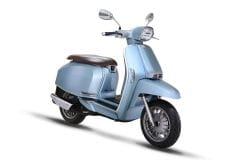
LAMBRETTA Scooter PDF Manuals
History of Lambretta Scooters
Above on the page there are several PDF Manuals & Parts Catalogs for LAMBRETTA Scooters.
Lambretta owes its birth to the Italian industrialist Ferdinando Innocenti. Before the WW2, he mastered the production of seamless water pipes and decided to put production on a grand scale.
In the vicinity of Milan in 1931, he built a factory, where more than six thousand people were employed. Things were going well, but then the war began.
Ferdinando Innocenti's plant was bombed by Allied aircraft - for a large industrial facility, the fate, however, is predictable.
After Italy's surrender, Innocenti decided to revive the pipe business and start producing something that is in demand.
Unlike Vespa, the first Lambretta turned out to be extremely utilitarian. Both wheels were cantilevered, that is, they were bolted on only one side.
Typically an airplane feature - it makes the wheels easier to change. The rear wheel was rigidly attached to the frame. Impacts from potholes were damped by the spring-loaded driver and passenger seats.
Directly under them was a fuel tank, from which fuel was fed into the carburetor by gravity - there was no need to install an expensive and capricious fuel pump.
Based on the same considerations of simplicity, two-stroke Lambretta engines were proposed to be filled with a mixture of gasoline and oil. The engine itself was located under the fuel tank and had forced air cooling by a fan.
The scooter accelerated to 72 km / h, and on one liter of gas-oil mixture it could drive about 70 km.
Due to its simplicity of design, the Lambretta could be repaired literally on the knee, using a few wrenches, a screwdriver, a couple of rags and a can of engine oil.
The Italians voted for reliability and maintainability with a lira: scooters manufactured by the Innocenti plant flooded the whole country.
In the first five years of production, models A, B and C scooters have sold just under 200 thousand copies.
The 1970s were approaching. The need for utilitarian transport came to naught, and even very poor citizens could afford cars.
The scooter renaissance did not begin in any way, despite the advanced technical solutions in the design of scooters.
It is worth mentioning that Lambretta scooters became the carriers of the first hydraulic disc brakes on two-wheeled vehicles.
Innovation didn't save the company. The motorcycle division of the industrial empire of Innocenti did not feel well and was sold to the British from the British Leyland Motor Corporation.
Instead of a business that the previous owner was blowing away dust particles from, scooter manufacturing is becoming just one of many for a UK engineering company.
It was the end. In 1972, the production of legendary scooters in their historical homeland was curtailed.
Negotiations between Automobile Products of India (somewhat later - Scooters India Limited) with the owners of the equipment and accessories were crowned with success, and the production of scooters under license was opened in India.
Lambretta were produced in almost authentic form right up to 1998.


